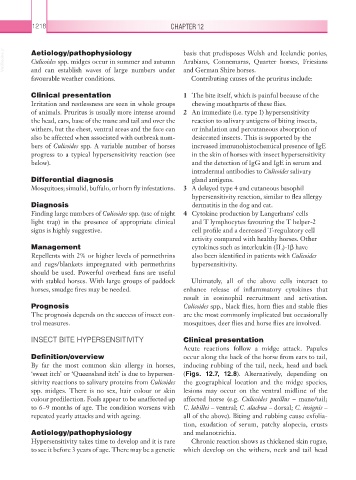Page 1243 - Equine Clinical Medicine, Surgery and Reproduction, 2nd Edition
P. 1243
1218 CHAPTER 12
VetBooks.ir Aetiology/pathophysiology basis that predisposes Welsh and Icelandic ponies,
Arabians, Connemaras, Quarter horses, Friesians
Culicoides spp. midges occur in summer and autumn
and can establish waves of large numbers under
Contributing causes of the pruritus include:
favourable weather conditions. and German Shire horses.
Clinical presentation 1 The bite itself, which is painful because of the
Irritation and restlessness are seen in whole groups chewing mouthparts of these flies.
of animals. Pruritus is usually more intense around 2 An immediate (i.e. type 1) hypersensitivity
the head, ears, base of the mane and tail and over the reaction to salivary antigens of biting insects,
withers, but the chest, ventral areas and the face can or inhalation and percutaneous absorption of
also be affected when associated with outbreak num- desiccated insects. This is supported by the
bers of Culicoides spp. A variable number of horses increased immunohistochemical presence of IgE
progress to a typical hypersensitivity reaction (see in the skin of horses with insect hypersensitivity
below). and the detection of IgG and IgE in serum and
intradermal antibodies to Culicoides salivary
Differential diagnosis gland antigens.
Mosquitoes; simulid, buffalo, or horn fly infestations. 3 A delayed type 4 and cutaneous basophil
hypersensitivity reaction, similar to flea allergy
Diagnosis dermatitis in the dog and cat.
Finding large numbers of Culicoides spp. (use of night 4 Cytokine production by Langerhans’ cells
light trap) in the presence of appropriate clinical and T lymphocytes favouring the T helper-2
signs is highly suggestive. cell profile and a decreased T-regulatory cell
activity compared with healthy horses. Other
Management cytokines such as interleukin (IL)-1β have
Repellents with 2% or higher levels of permethrins also been identified in patients with Culicoides
and rugs/blankets impregnated with permethrins hypersensitivity.
should be used. Powerful overhead fans are useful
with stabled horses. With large groups of paddock Ultimately, all of the above cells interact to
horses, smudge fires may be needed. enhance release of inflammatory cytokines that
result in eosinophil recruitment and activation.
Prognosis Culicoides spp., black flies, horn flies and stable flies
The prognosis depends on the success of insect con- are the most commonly implicated but occasionally
trol measures. mosquitoes, deer flies and horse flies are involved.
INSECT BITE HYPERSENSITIVITY Clinical presentation
Acute reactions follow a midge attack. Papules
Definition/overview occur along the back of the horse from ears to tail,
By far the most common skin allergy in horses, inducing rubbing of the tail, neck, head and back
‘sweet itch’ or ‘Queensland itch’ is due to hypersen- (Figs. 12.7, 12.8). Alternatively, depending on
sitivity reactions to salivary proteins from Culicoides the geographical location and the midge species,
spp. midges. There is no sex, hair colour or skin lesions may occur on the ventral midline of the
colour predilection. Foals appear to be unaffected up affected horse (e.g. Culicoides pusillus – mane/tail;
to 6–9 months of age. The condition worsens with C. lahillei – ventral; C. alachua – dorsal; C. insignis –
repeated yearly attacks and with ageing. all of the above). Biting and rubbing cause exfolia-
tion, exudation of serum, patchy alopecia, crusts
Aetiology/pathophysiology and melanotrichia.
Hypersensitivity takes time to develop and it is rare Chronic reaction shows as thickened skin rugae,
to see it before 3 years of age. There may be a genetic which develop on the withers, neck and tail head

